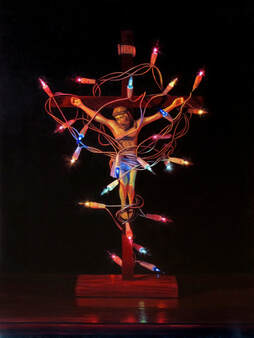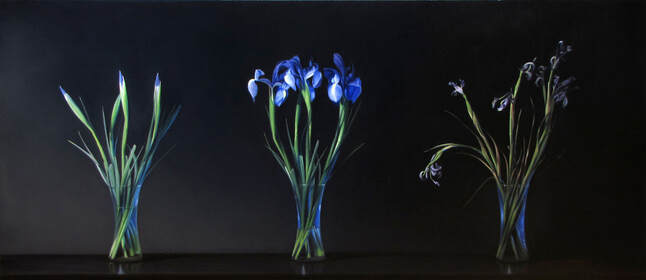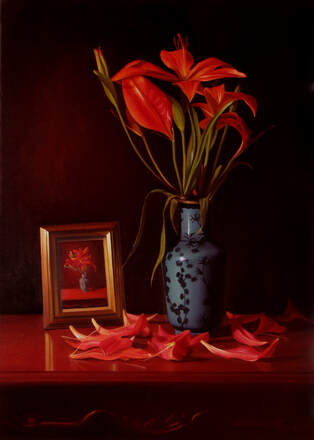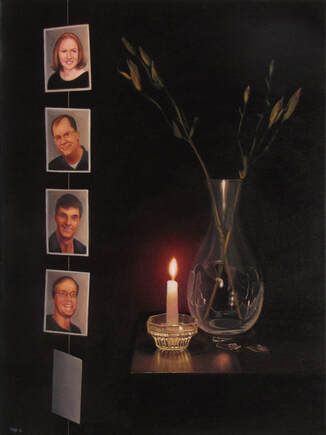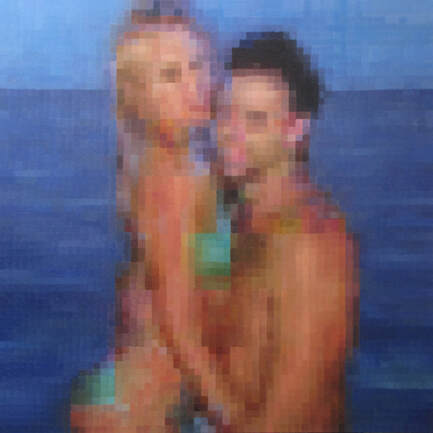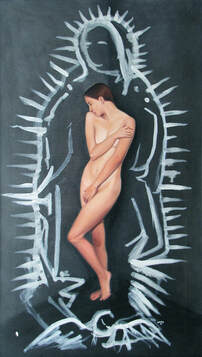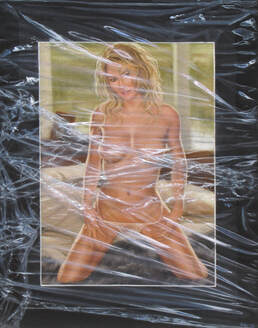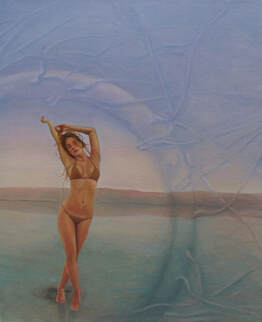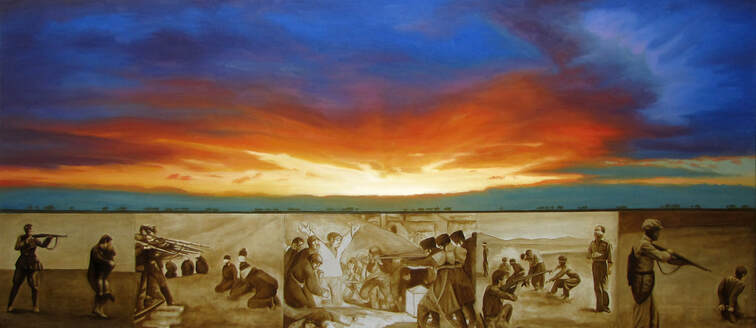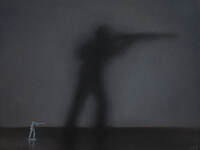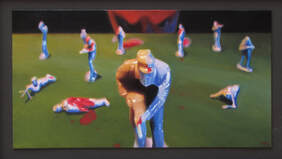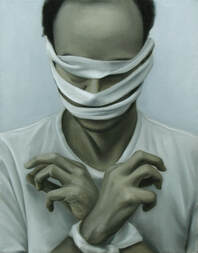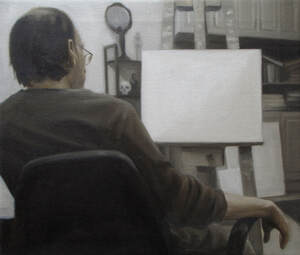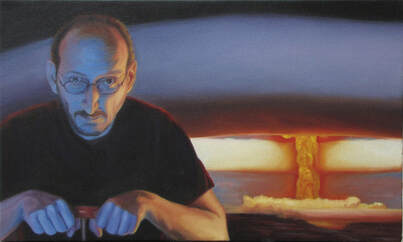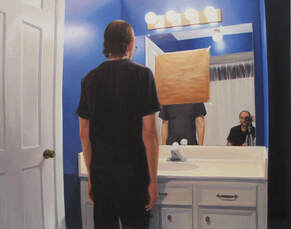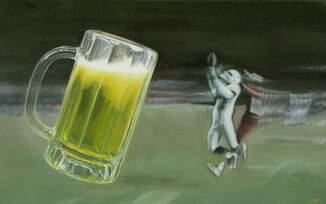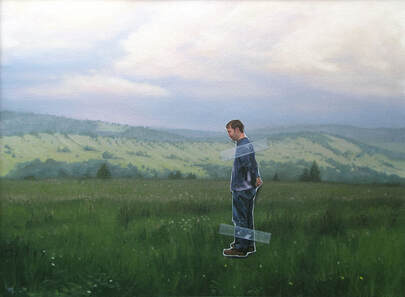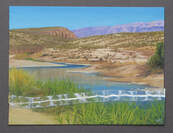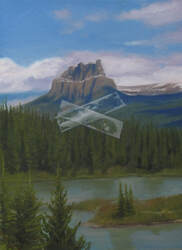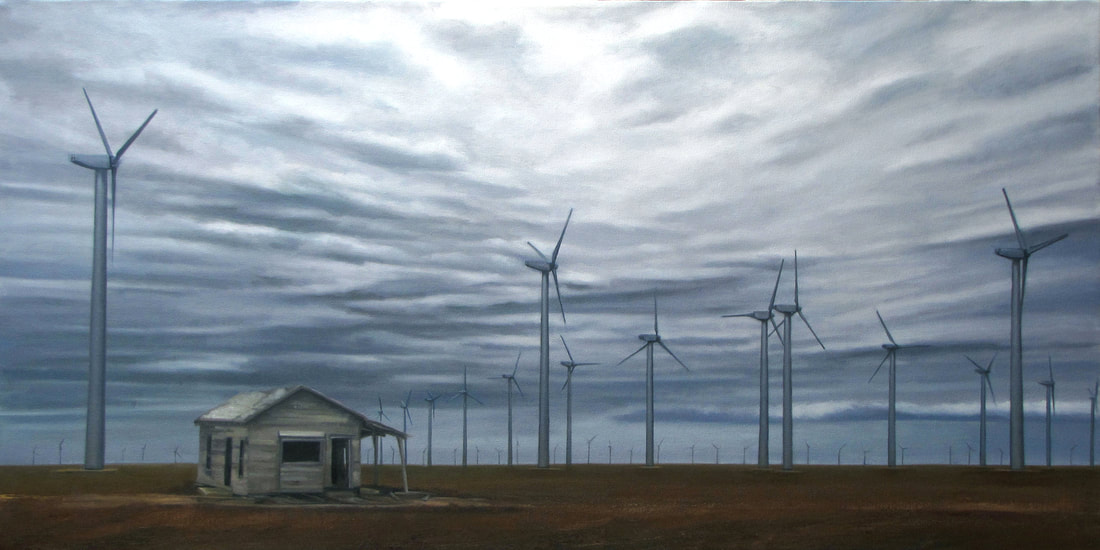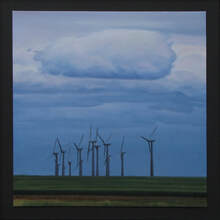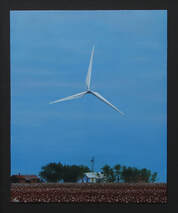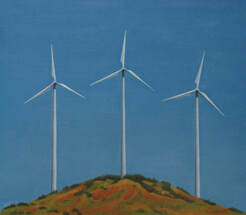INAPPROPRIATE
For a Public Space
This series of conceptual paintings for a show at Archway Gallery in 2012.
The title for this show came about from some recent experiences in applying to juried competitions which were to hang in public spaces. To avoid controversy, the rules for such exhibits preclude any work involving sex, violence and religion. And I thought: “Well, that’s pretty much most of my work”. Sometimes I get solicitations for hospitals, which, of course, would also preclude the subject of death. And that pretty much covers the rest of my work.
Although I have in the past structured my solo shows around particular themes, lately I have abandoned this restrictive idea for the freedom to paint whatever I am drawn to. I keep a list of ideas and images that I wish to pursue. The order of their execution is usually dictated by my passion for the image and the availability of the required model, materials and my own painting skills. There are ideas that have lain dormant for years for want of the right materials. Many of the pieces I had thought would be in this show still lie in wait on my list. The end result is not what I had anticipated over two years ago when I began work.
What separates this show from previous ones is a shift from the intellectual towards the emotional. My turning inward has been prompted by events that have occurred since my last show: turning 50, the loss of some good friends as well as the loss of both of my parents.
Though they may originate from the personal, my hope is that the work speaks universal truths, which is the key to good art.
The title for this show came about from some recent experiences in applying to juried competitions which were to hang in public spaces. To avoid controversy, the rules for such exhibits preclude any work involving sex, violence and religion. And I thought: “Well, that’s pretty much most of my work”. Sometimes I get solicitations for hospitals, which, of course, would also preclude the subject of death. And that pretty much covers the rest of my work.
Although I have in the past structured my solo shows around particular themes, lately I have abandoned this restrictive idea for the freedom to paint whatever I am drawn to. I keep a list of ideas and images that I wish to pursue. The order of their execution is usually dictated by my passion for the image and the availability of the required model, materials and my own painting skills. There are ideas that have lain dormant for years for want of the right materials. Many of the pieces I had thought would be in this show still lie in wait on my list. The end result is not what I had anticipated over two years ago when I began work.
What separates this show from previous ones is a shift from the intellectual towards the emotional. My turning inward has been prompted by events that have occurred since my last show: turning 50, the loss of some good friends as well as the loss of both of my parents.
Though they may originate from the personal, my hope is that the work speaks universal truths, which is the key to good art.
Although at first glance this piece may appear to be very irreverent, it can be interpreted as a deeply spiritual piece, in which the materialistic holiday lights of the corporeal world overpower the religious icon of the spiritual world. The lights have been wrapped around the crucifix in such as way as to mimic the crown of thorns – associating the lights with torture.
Sometimes flowers and plants become highly evocative of elderly people and the iris has done a good job. I stage a narrative across the canvas showing youth, maturity and old age. These irises took some time to grow and fade and this inadvertently added another interesting effect: the water level drops in each image, being completely dry at the end. The loss of the water symbolizes the loss of the life essence.
|
We love photographs, but photographs don’t love us back. They are reminders of our mortality. Without them, the aging process would not be so apparent.
This lily dropped all its petals providing an even starker reminder of senescence. Its photo from better days mocks its loss of vitality and sexual energy (the flower is a sexual organ, after all). The curse here can be seen in two ways: the curse of old age itself or the curse of the photograph - the hateful reminder of lost youth and beauty. Accepted into the Visual Arts Alliance Show, Houston, TX, May, 2012 |
A homage to some dear friends lost before their time: Britteny, Dale, Walter and Steve. Accidents and illness took their lives too soon. The last photo remains out of view. Sadly, between the time I started this piece and its completion another friend died prematurely.
On the right are the dead flowers; in this case lilies, that have died before their buds have opened. The vase is cracked and the life giving water drained away. The short candle enhances the feelings of mortality. We are all hanging by a thread. |
During an internet search for an image for another painting, I stumbled across this thumbnail:
Naturally, when I downloaded it and enlarged it, it became nothing but a mass of pixels. This struck me as significant and I decided to modify the thumbnail and make it into a large piece. There are 60 rows and columns to this three-foot painting. That’s 3,600 squares.
The chosen title imparts a specific meaning to the piece: the happy couple only appears as such from a distance. Even from far away, the beauty and happiness is barely visible. One is tempted to move closer, but the illusion fades into meaningless squares. Only at an infinite distance does the picture coalesce, at which point it becomes too small to be visible. How often is it that the things that are seen are not what they appear?
The chosen title imparts a specific meaning to the piece: the happy couple only appears as such from a distance. Even from far away, the beauty and happiness is barely visible. One is tempted to move closer, but the illusion fades into meaningless squares. Only at an infinite distance does the picture coalesce, at which point it becomes too small to be visible. How often is it that the things that are seen are not what they appear?
Many religions seem to have a disparaging view of sex, viewing it as only a means to reproduction and associating its enjoyment with evil. For Christianity, this is epitomized by the Virgin Mary, the holiest of women, who could conceive without performing the sex act. The end result of this belief is sexual shame.
This woman stands in a shameful pose covering her sex, surrounded by a stylized outline of the Virgin of Guadalupe.
This woman stands in a shameful pose covering her sex, surrounded by a stylized outline of the Virgin of Guadalupe.
|
At first glance this trompe l'oeil is rather amusing. Yet it is a comment on the packaging of beauty, sex as a marketing tool, pornography as a substitute for genuine affection, and the objectification of women.
|
I have taken the ubiquitous sex image (a fine example from the Masturbation Issue of Sports Illustrated) and superimposed upon it a human egg in the process of fertilization:
The intent is to highlight the purpose of such sexual attractiveness: reproduction. The sperm releases the beauty to attract the mate to be replicated again in an endless process in which the participants (both male and female) are but pawns with illusions of free will.
|
This piece started with a newspaper article on the infamous photo of the firing squad taken after the Iranian revolution (second from right). I don't recall if the article mentioned it, but I immediately thought of Goya's famous painting of the execution of Spanish nationalists resisting Napoleon (in the middle). Later, I thought of placing this sunset over them, and then adding more such images. I think the sunset (or sunrise really) can be thought of a number of ways: as a poignant contrast, as the vision for which they sacrificed themselves, as an image of past happiness, future paradise or impending death, etc.
I adjusted the contrast of the lower images to coincide with the light in the sun image above. I am particularly happy with the lightness of the center figure in Goya's piece (this contrast was used to great effect by Goya, which I have heightened). The lower images were painted with a limited palette (black and raw umber with traces of white) and the light areas are unpainted canvas, where the light canvas primer shows through.
I adjusted the contrast of the lower images to coincide with the light in the sun image above. I am particularly happy with the lightness of the center figure in Goya's piece (this contrast was used to great effect by Goya, which I have heightened). The lower images were painted with a limited palette (black and raw umber with traces of white) and the light areas are unpainted canvas, where the light canvas primer shows through.
|
This piece can be read in many ways, which is what I like about it. The menace of the shadow could be seen as false as it is only cast by a toy soldiers; the menace could be the child playing war who someday will become the man and play for real; or the war is just some men playing games with real lives.
Accepted into the Visual Arts Alliance Show, Houston, TX, November, 2011 |
This piece is a compliment to "Menace". Here, the image is far more explicit: the toy soldiers are actually bleeding. The commander may be seen in the background lit in a sinister red light presumably ordering the 'men' forward.
Accepted into The Big Show, Lawndale Art Center, Houston, TX, July, 2013 |
|
This piece was borne from my frustrations with the limitations of my senses: inability to see clearly, hear clearly, smell subtleties, taste nuances, or manipulate objects. There is deeper level: the struggle between the will and the body; between the spirit and the flesh. That feeling of being imprisoned in a body, in this place at this time. Commensurate with this is the overwhelming desire to break free – a freedom which sometimes can be touched through prayer, meditation, drugs or alcohol. But freedom never comes. So there is a struggle to accept the imprisonment, because without acceptance there can be no happiness.
Accepted into the Hunting Art Prize, Houston, TX, 2013 |
When not sure what to paint, paint uncertainty. Here, I stare at the blank canvas waiting for inspiration, surrounded by objects in my studio (note the skull in the background). The blank canvas may be thought of as the mind waiting for enlightenment.
Accepted into the Visual Arts Alliance Show, Houston, TX, May, 2012 |
|
I was originally going to name this piece “Blow Up the Outside World” after a song by Soundgarden. It reminded me of past anger and frustration and its violent imaginings. Then I drew the connection of this feeling to Thoreau’s famous phrase from “Walden” that “The mass of men lead lives of quiet desperation”.
|
A portrait about myself of many years ago in which I had considered covering all the mirrors in my home so that I wouldn't have to look at my own face. Fortunately, things have improved. As such, I added my modern self as reflected in the mirror taking the picture. My self of the present day contemplating my self of the past.
|
|
Based on a famous quote from ancient Rome, this piece draws a parallel between antiquity and modernity.
I took this picture of my computer screen during a broadcast of a college football game - the modern circus. I miraculously captured a critical moment and the photo is wonderfully blurred which so helps to define the sense of motion. The bread has been replaced with good old beer. |
Once every couple of years or so I take a vacation and go hiking into some scenic area, deluding myself that I am ‘in nature’. Of course, in reality if I were left alone there, I would be dead from exposure before day’s end.
Truth is, like many, I have become completed disconnected from nature. I am unaware of the seasonal effects of sun and the stars, the growth and decay of plants, animals that survive in my local environment, etc. I am incompetent outside of the modern city. These occasional sojourns into the country are poor substitutes for a true experience. I have symbolized this by presenting the man (my friend and sculptor James Racine) as a cutout over the landscape. |
|
Here I used the trompe l'oeil to simulate a torn piece of paper. The landscape chosen is the Rio Grande, near Big Bend Park. The tear can be seen to symbolize the border between the two nations.
|
I decided to do this trompe l'oeil piece just for the hell of it. It is purely Dada.
|
|
Along Texas Highway 84 sits this shack amidst the cotton fields and windmills of the Texas Panhandle. I made this trip many times in the last four years visiting a friend in Lubbock and this shack always caught my eye: the irony of this decay amongst the windmills.
I chose a cloudy day for the scene as that seemed to match the mood of the piece. The arrangement of the windmills is my own doing. I chose two lines of perspective for them which cross on the center right of the painting. The proximity of the two windmills at this point makes an interesting point of tension. |
I was drawn to this scene because the cloud was perfectly aligned over the windmills and thus made an interesting composition.
|
|
I was painting a windmill near a farmhouse with the cotton in full bloom. After painting the blades, I suddenly thought 'this painting is finished'. And this is where I left it.
|
Three windmills on a hill draw an allusion to the three crucifixes on Calvary, also known as Golgotha.
|
